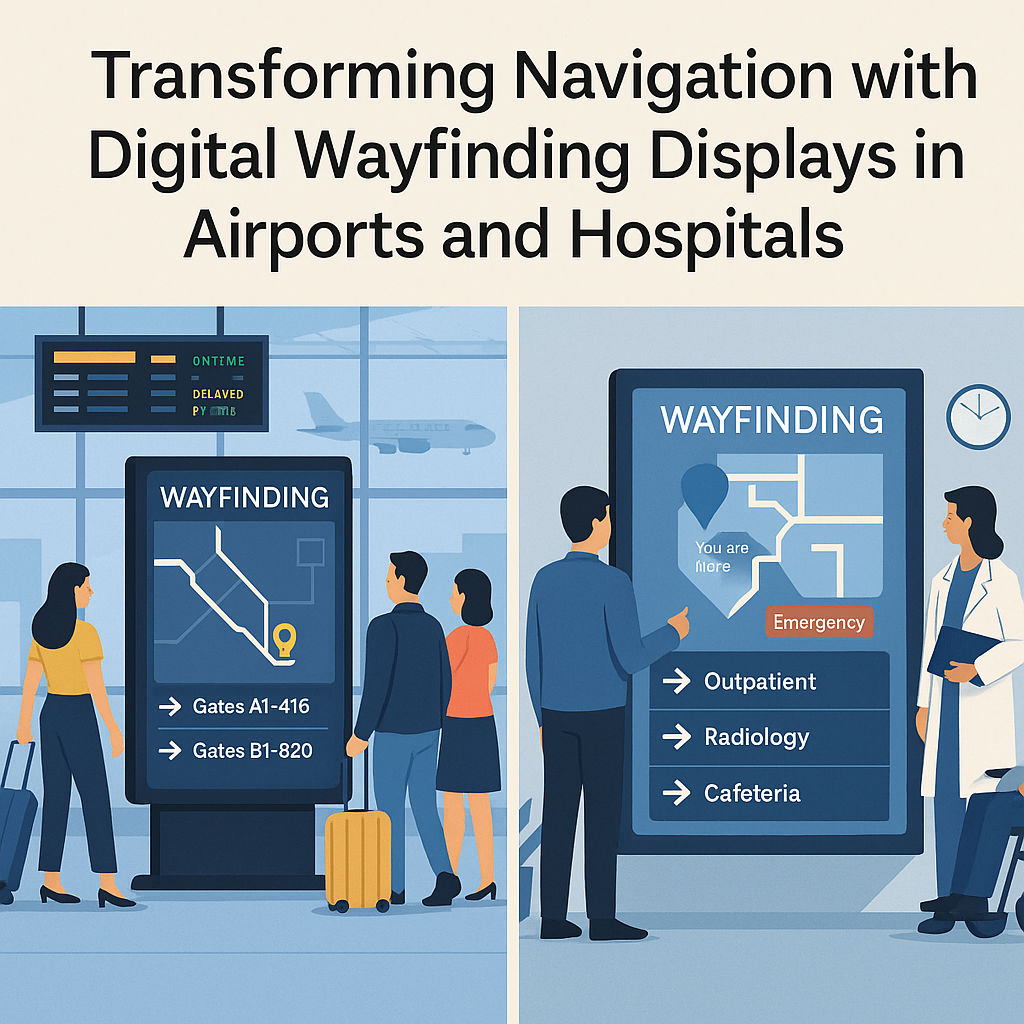· Nikita · 3 min read
Transforming Navigation with Digital Wayfinding Displays in Airports and Hospitals

Wayfinding displays have revolutionized navigation in high-traffic areas like airports and hospitals. These digital tools not only make it easier for visitors to find their way but also improve operational efficiency and overall user experience. Let’s explore their significance, unique features, and the innovative trends shaping the future of wayfinding. For instance, Istanbul Airport features the world’s largest set of digital indoor LED signage, with 700 Samsung Smart LCD and LED displays covering an area of 1,012 square meters, assisting passengers in finding their way efficiently.
The Importance of Digital Wayfinding in Airports and Hospitals
1. Simplifying Complex Layouts
Airports and hospitals are notoriously large and complex. Visitors can easily feel lost, adding stress to their journeys or appointments. Digital wayfinding displays provide intuitive, real-time directions that reduce confusion and enhance accessibility.
2. Enhancing User Experience
For passengers rushing to catch flights or patients navigating to critical appointments, seamless navigation ensures a stress-free experience. Clear directions and easy-to-understand interfaces create trust and satisfaction.
Core Features of Wayfinding Displays
1. Airports:
Real-Time Flight Updates: Displays show gate changes, flight delays, and boarding times. Multilingual Support: Essential for accommodating international travelers. Retail Guidance: Directing passengers to shops, lounges, and dining areas. Emergency Evacuation Assistance: Real-time updates during emergencies ensure safety.
2. Hospitals
Department Locators: Simplified directions to wards, labs, and facilities. Appointment Assistance: Digital kiosks for patient check-ins. Accessibility Features: Tools for visually or hearing-impaired visitors. Visitor-Friendly Navigation: Custom maps for different wings and floors.
Unique Perspectives on Wayfinding Displays
1. Eco-Friendly Solutions
Replacing traditional paper maps with digital displays significantly reduces waste. Additionally, renewable energy-powered kiosks align with sustainability goals.A mid-sized hospital can save over 10,000 paper maps annually after switching to digital systems.
2. Augmented Reality (AR) Integration
AR overlays on smartphones or smart glasses make navigation interactive, guiding users with virtual arrows or highlighted paths in real-time.
3. Beacon Technology
Beacons enable hyper-accurate indoor positioning, helping users locate themselves precisely within large spaces.
4. Gamified Navigation for Engagement
Imagine integrating gamification into wayfinding displays. For example, airports could offer “treasure hunts” for children, guiding them to key areas while keeping them entertained. Hospitals could use this concept to make pediatric wards less intimidating for young patients.

Benefits of Digital Wayfinding
Airports:
- Reduced Stress and Missed Flights: Clear guidance minimizes confusion and ensures timely boarding.
- Increased Retail Revenue: Displays encourage shopping and dining by directing visitors to amenities.
- Crowd Management: Dynamic updates help manage passenger flow during peak hours.
Hospitals
- Improved Patient Satisfaction: Easy navigation reduces anxiety for patients and visitors.
- Lower Administrative Burden: Fewer staff are needed to assist visitors with directions.
- Emergency Navigation: Quick access to critical areas during crises.
The Future of Wayfinding Displays
Predictive Navigation
AI-driven systems will predict crowd flow, adjust routes dynamically, and even suggest the best paths based on user preferences.
Voice-Activated Signage
Voice assistance will make navigation more inclusive for visually impaired users or those unfamiliar with touchscreen technology.
5G-Enhanced Displays
With faster connectivity, displays will deliver real-time updates and interactive content seamlessly.
Virtual Assistants for Personalized Navigation
Future wayfinding displays could include integrated virtual assistants that provide step-by-step guidance. For instance, a voice-activated system might greet users, ask for their destination, and guide them through an optimal path while considering real-time obstacles like maintenance or crowds.
Conclusion
Digital wayfinding displays are more than just tools for navigation; they’re a vital part of enhancing visitor experience, improving efficiency, and aligning with modern sustainability goals. Airports and hospitals that adopt these technologies position themselves as leaders in user-centric innovation, ensuring that every visitor feels guided and cared for from start to finish.

